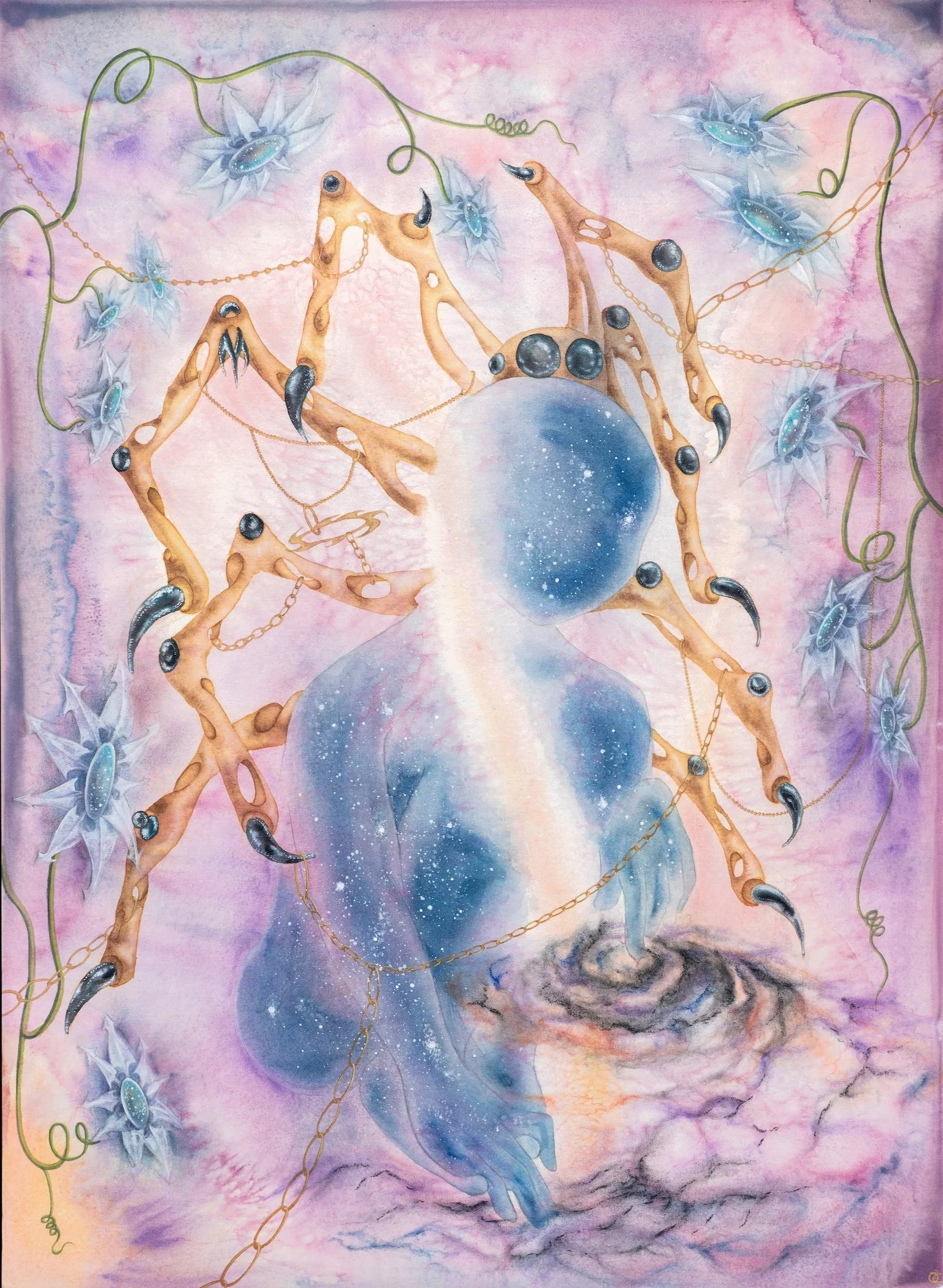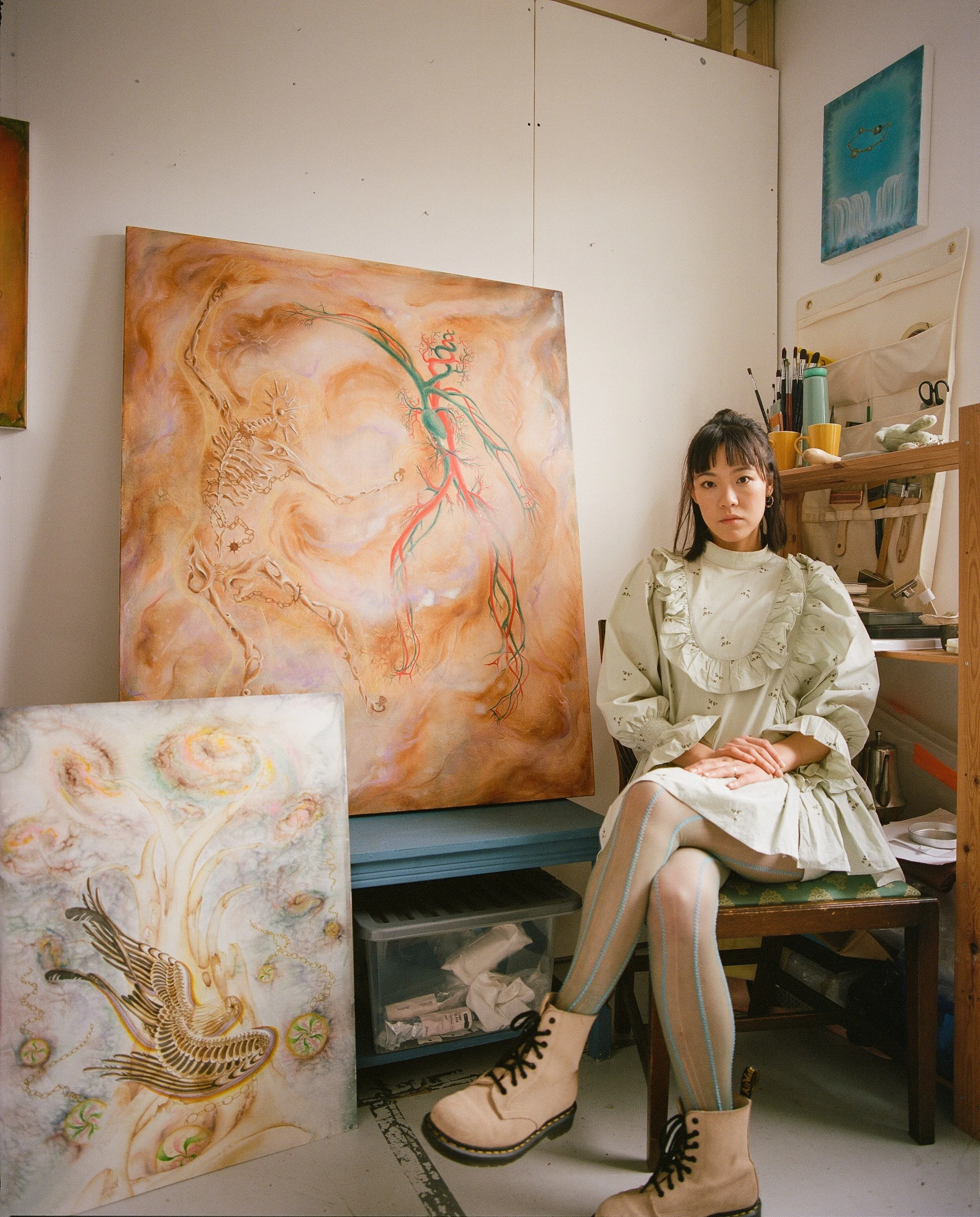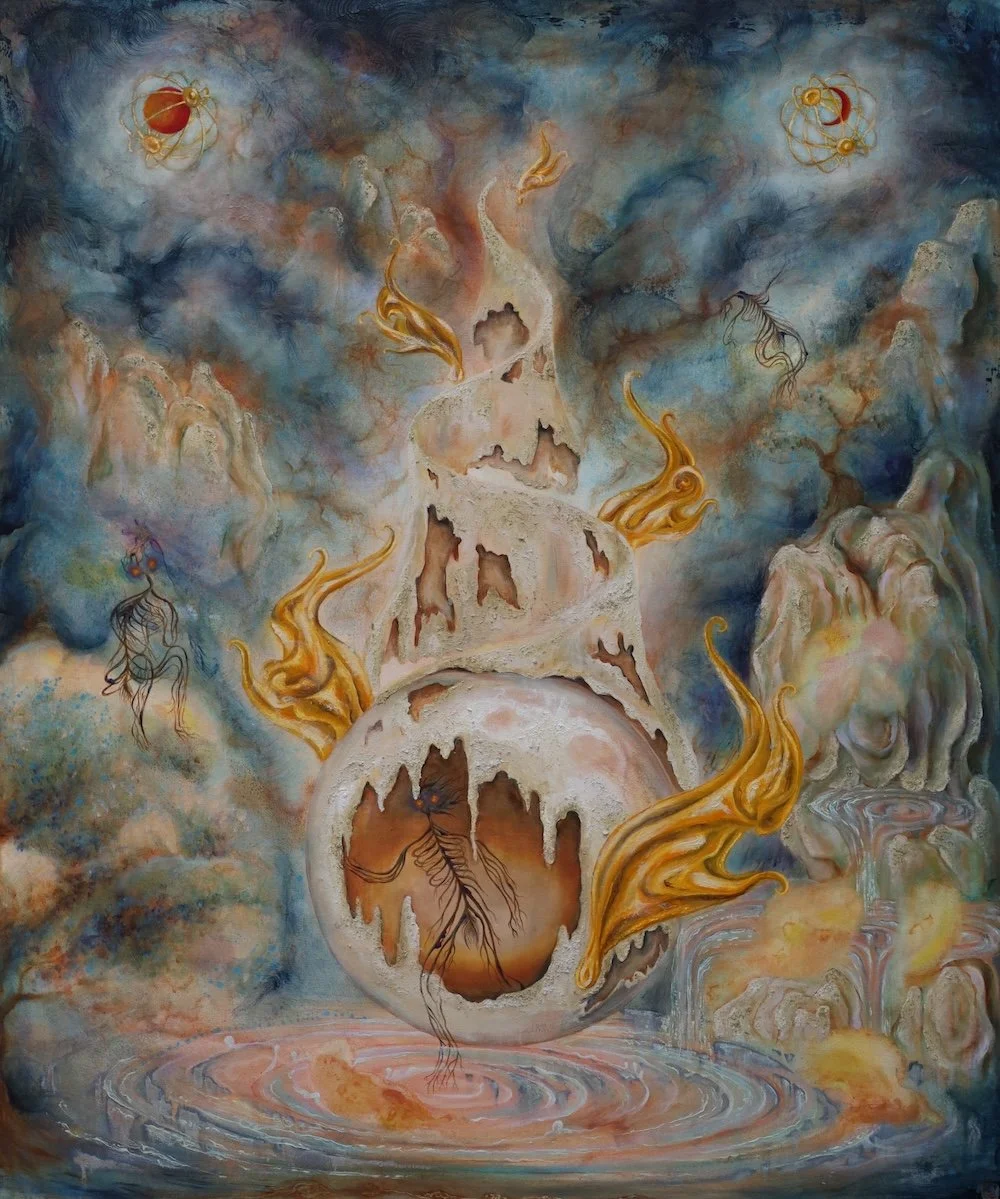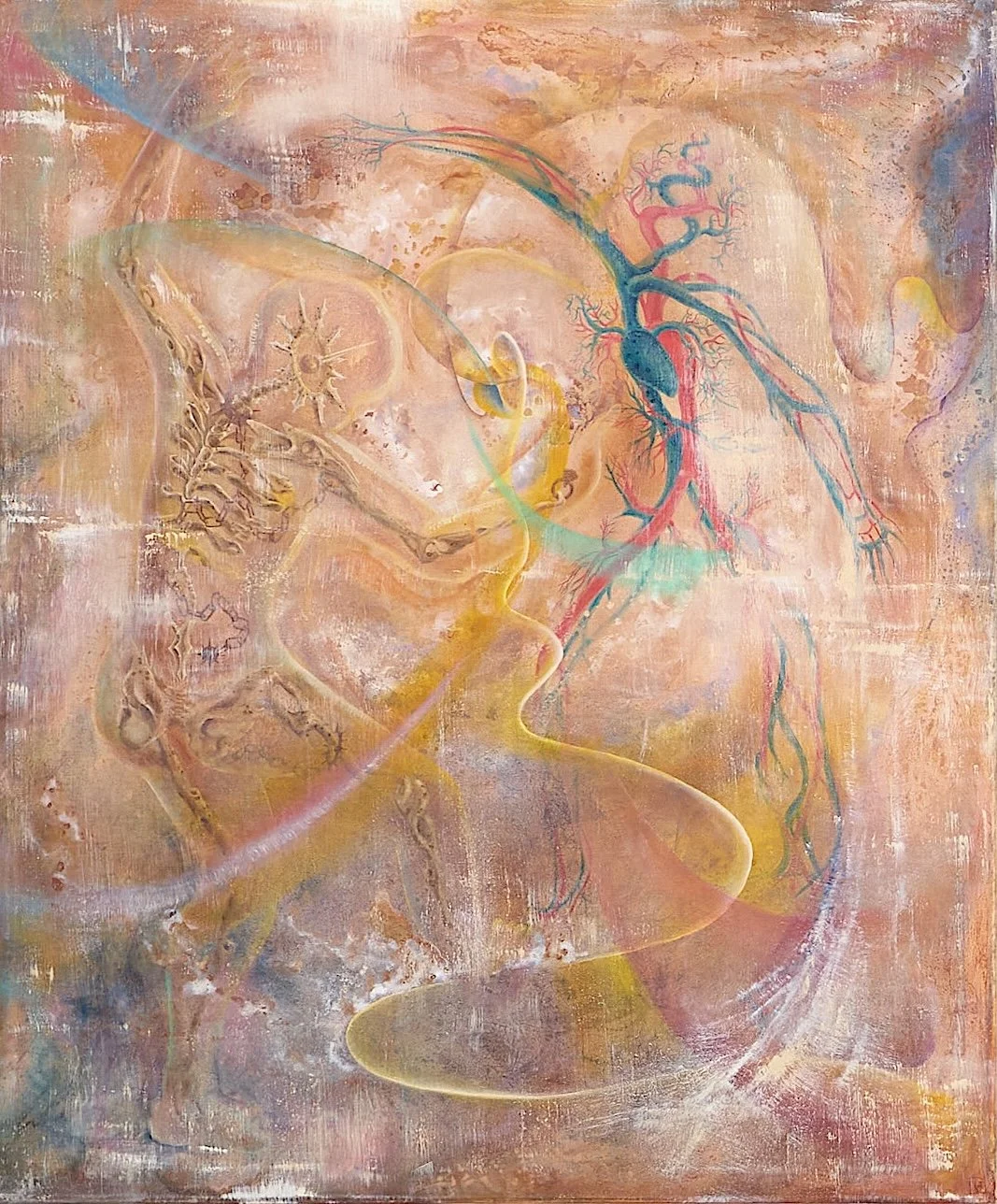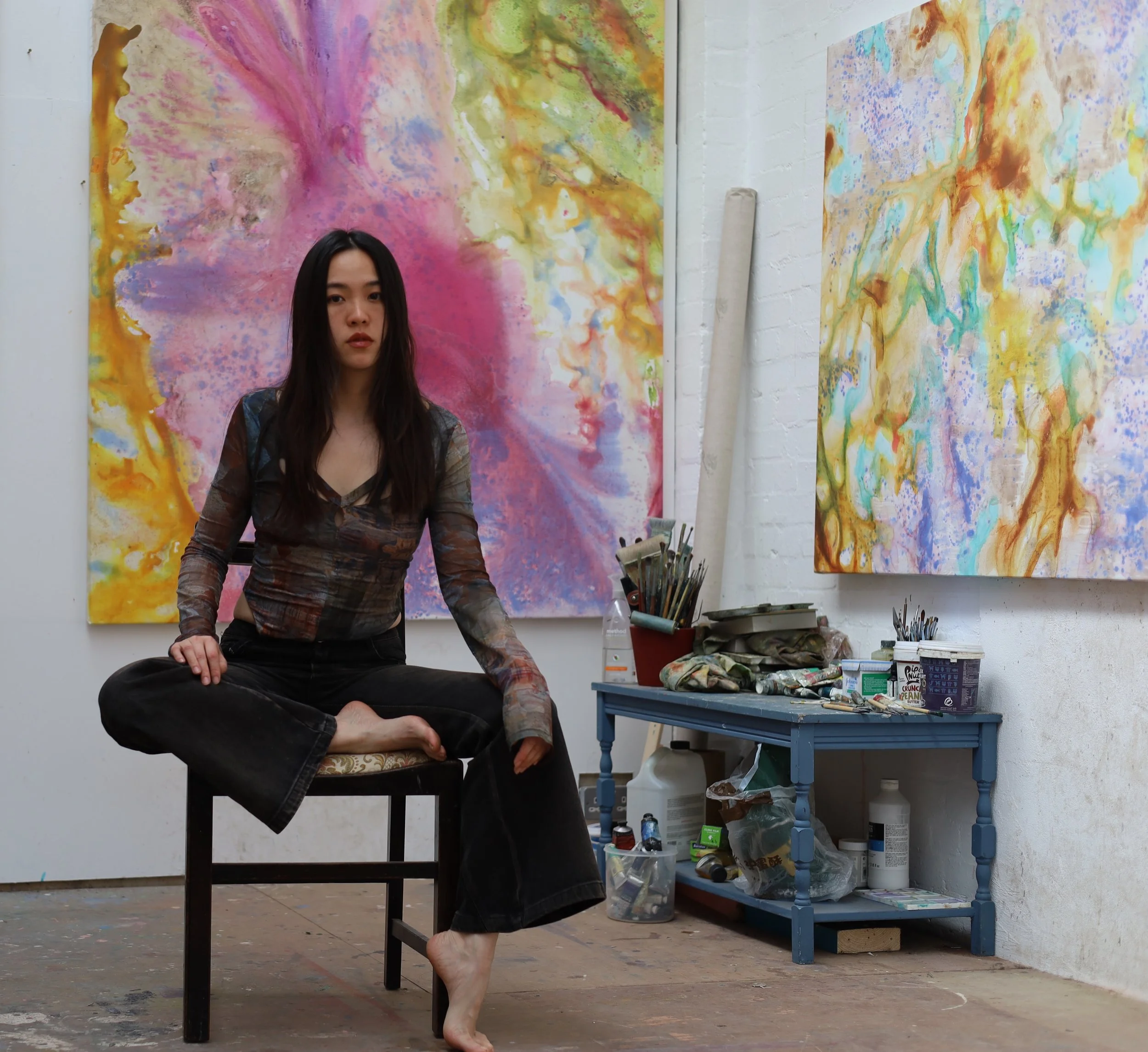Qian Qian
Qian Qian (b. 1990, China) is a London-based interdisciplinary artist whose work spans painting, interactive installation, and social practice. Drawing on her background in journalism and a lifelong engagement with art, she explores spiritual-material dualities, cultural hybridity, and interconnectedness through myth-informed and research-driven processes. She earned her MFA in Fine Art from Goldsmiths, University of London in 2018. Her practice creates spaces—physical and conceptual—that invite reflection, interaction, and sensory engagement
As a visual artist, poet, and mother, I explore the transformation of the body and the rhetorical role of technology through watercolor, oil painting, and interactive installation. Blending chaos and control, I develop techniques inspired by Max Ernst’s ‘controlled chance,’ adapting the fluid textures of watercolor to oil and building “ecomythic” visions of body, energy, and memory. My work draws from Zen Buddhism, alchemy, Gaia theory, quantum consciousness, and cosmotechnics, merging sci-fi mythopoetics with material experimentation. In projects like People Should Listen to the Birds’ Flight, I integrate ceramics, sound, and touch, using field recordings and digital interfaces to create immersive, multi-sensory experiences. Across media, I examine how technology, far from alienating us, can re-enchant perception and reconnect us to nature’s subtle rhythms.
Artist Statement
Instagram: Ivyivymuami
Website: qianqianart.org
Photo by Matthew Coles
Hi Qian, tell us about your background. How and when did you first start to paint?
At the age of 5, I determined my career path, torn between becoming an astronomer or a painter. I have been going to art classes every weekend ever since, until I was sent to a boarding school away from my family when I was 14. Because of the immaturity of adolescence and pressure from my parents, I had to study law for my university and master degree. After graduation, I found a job as a journalist in an art magazine. During the day I write articles about artists I interviewed, and during the night I make oil paintings. As I slowly built my portfolio, I took the chance to move from China to the UK in 2015 to pursue an MFA at Goldsmiths.
How do you begin to work? What is your process like?
My painting rituals are simple yet effective for me. I usually start by putting on some music—often Late Junction on BBC Radio 3 or something from the NTS channels—then light an incense stick, and I’m ready to begin. I start with a vague image in mind, often inspired by what I’ve been reading, and I work intuitively in that direction.
How does your personal experience as a mother and Chinese immigrant in London shape the themes of interconnectedness and cultural hybridity in your work?
The best example would be my interactive installation, People Should Listen to the Birds’ Flight. The title is a sentence from Bruno Schulz’s novel Crocodile Street. I noticed that the English translation of this sentence did not carry the same nuance as the Chinese version I originally read, where the word “flight” takes the form of a birdlike hieroglyph, combining elements that depict feathers. Together, they symbolize the stillness and straightness of a bird in flight.
Acknowledging the failure of translation to fully convey this subtlety, I chose to encrypt messages into Braille code slabs. The poetics of the sentence extend beyond silence and the physicality of the page. The installation explores ideas of form and emptiness, visual and vocal, coding and decoding, low-tech and high-tech, transforming the act of reading into an ambient and interactive experience.
The installation integrates bird mythologies from different cultures. For example, the Kalaviṅka—a bird said to sing before it is born—is paired with a recording of my baby’s heartbeat during a prenatal checkup. Touch, often considered taboo in both traditional and contemporary art, is one of our earliest and most profound senses, connecting us to our first memories. By using Braille—a tactile language—the work reclaims this sense, grounding the experience in a way that is coherent and integral to the piece.
I try to find divine moments in the everyday sounds around me. Viewers, separated from the literal meaning of the sentence, must discover it themselves by engaging with the piece. As they interact, they trigger interfaces that generate sound: birds singing, wings flapping, cars roaring, footsteps pacing—urban soundscapes intertwined with intimate, private moments. This anti-anthropocentric approach shifts focus from the viewer to the larger interconnected stories embedded in the work, reflecting the silent flight of birds.
Chiliocosm Daydreaming_Oil, acrylic and watercolor on canvas_100 x 120 cm_2024
Your concept of "ecomythticism" combines mythology and science. How do you balance these seemingly contrasting spheres in your artistic narrative?
I see mythology and science as parts of a continuum in human history. What we now call mythology was once our ancestors’ way of understanding the universe, often anthropomorphically. Similarly, today’s science might be viewed as incomplete or even pseudo-scientific by future generations. Both are linear records of humanity’s attempts to mimic, understand, reshape, and create nature.
Themes of chaos and control, consciousness and subconsciousness, and the interplay of materiality and energy feature prominently in your work. What inspired your interest in exploring these dualities?
I’m fascinated by the interplay of dualities rather than viewing them as opposites. Like the poles of a magnet, they are connected by invisible forces, creating a field within which order emerges. These dualities act as magnets in my practice, and through my paintings, I seek to reveal the unseen connections between them.
Your imagery ranges from microscopic cells to macroscopic galaxies. How do you select and integrate these diverse motifs to convey your themes of interconnectedness and flux?
I’m deeply inspired by mythological imagery from esoteric works and primitive cultures, such as alchemical illustrations, Navajo medical paintings, and ancient Iranian anatomy. Cross-cultural motifs like the cosmic egg or the principle of "as above, so below" recur across these references. My style and choice of elements are profoundly influenced by these visual languages, which reflect universal ideas of interconnectedness.
Philosophical concepts like Gaia theory and quantum consciousness deeply influence your work. How do you translate these abstract ideas into a visual language that resonates with audiences?
Recently, I’ve been reading about quantum spin—how electrons exist in a superposition before collapsing into a specific state. This concept, though abstract and bizarre, resonates with me. My background in physics, though cut short by unforeseen circumstances, shaped my way of thinking, especially when engaging with abstract representations of the world.
Similarly, language itself is an inherently abstract representation. My paintings, which balance abstraction and figuration, create a dialogue that draws audiences in through relatable elements while maintaining a sense of distance. This interplay invites viewers to navigate between the familiar and the surreal.
Your art engages with spiritual-material duality and mythopoetic sci-fi imagery. What role does storytelling play in your creative process, and how do you hope it engages viewers?
I explore narratives that merge mythology and contemporary science, intertwining them with my personal experiences and the broader contemporary moment. These narratives act as threads connecting past, present, and future.
Living in a culturally diverse city like London, how has your environment informed your exploration of identity and provided new perspectives on your artistic practice?
Living in London has given me the freedom to pursue my beliefs and embrace my differences with confidence. This environment has encouraged me to explore my identity through new and diverse lenses.
Describe a real-life situation that inspired you.
I enjoy my daily walks to and from the studio. These moments are opportunities to practice mindfulness and immerse myself in the present. I focus on small details—a fallen leaf, a crack on a wall, a gust of cold wind, or a passing stranger. I strive to experience these moments as they are, free from the filters of memory or conscious thought. It’s challenging, but it reminds me of the habitual nature of our perception of time. When I think about breaking a second into milliseconds or even smaller units, I wonder if it’s possible to experience these fragments as infinite. Perhaps this is how protons perceive time.
New Angel_Watercolor and mixed media on archival board_56 x 76 cm_2023
Finitude Unchained in Late Spring Blossoms_Watercolor and mixed media on archival board_56 x 76 cm_2024
The Drifter_Watercolor and mixed media on archival board_56 x 76 cm_2023
Oracle_Watercolor and mixed media on archival board_56 x 76 cm_2024
Last Evenings in the Heliosphere_Oil on canvas_100 x 120 cm_2024
In a Greenhouse Somewhere_Watercolor and mixed media on archival board_56 x 76 cm_2024
Omnia_Oil, acrylic and watercolor on canvas_100 x 120 cm_2024
Whispers on the Solar Wind_Oil on canvas_100 x 120 cm_2024
Three Registers_Watercolor and mixed media on archival board_56 x 76 cm_2024
Orbita_Watercolor and mixed media on archival board_56 x 76 cm_2023
Portrait 3_Oil on linen_40 x 50 cm_2024
Qian Qian
These dualities act as magnets in my practice, and through my paintings, I seek to reveal the unseen connections between them.


